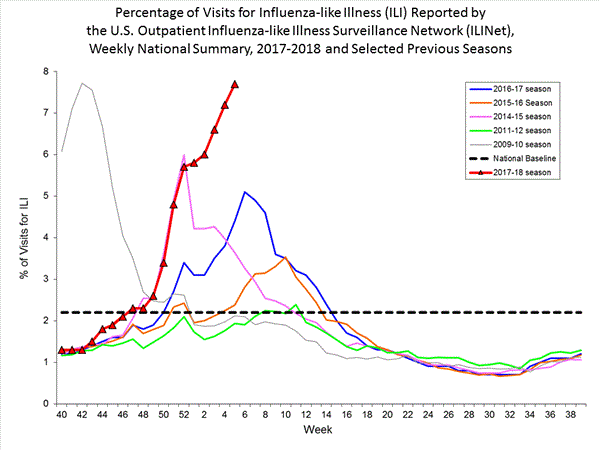Flu season on track to break recent records as illnesses reach 2009 level

Influenza and pneumonia killed around 10% of the people who died in the United States during the most recent week with available data — one of several grim statistics underscoring what health officials say is an historically bad influenza season.
According to acting CDC Director Anne Schuchat, MD, the season has shown few signs of slowing down, with several key markers of severity hitting or approaching record peaks. One of them, the percentage of outpatient and emergency clinic visits attributed to influenza-like illness (ILI), has reached the peak level of the 2009 pandemic, a signal of just how intense this nonpandemic season has been, Schuchat said.
The ILI rate was 7.7% during the week ending Feb. 3 — higher than the previous record for a nonpandemic season of 7.6% in 2003-2004 and equaling the rate in 2009.
“We were hoping to have better news to share today, but unfortunately it looks like this flu season continues to be particularly challenging,” Schuchat said during the CDC’s weekly briefing on influenza. “Our latest tracking data indicate that influenza activity is still on the rise overall.”

In another telling statistic, the CDC said the rate of laboratory-confirmed hospitalizations due to influenza reached 59.9 per 100,000 people, approaching the final rate in 2014-2015, a recent benchmark for bad influenza seasons.
The CDC reported 10 more pediatric deaths attributed to influenza, bringing the total to 63 for the season, and said 10.1% of overall deaths that occurred in the U.S. during the week ending Jan. 20 were attributed to influenza and pneumonia.
According to Schuchat, there have been an unusual level of hospitalizations in nonelderly adults this season: 63.1 per 100,000 patients aged between 50 and 64 years — much higher than the rate of 35.2 per 100,000 patients in the same age group in 2014-2015. Worse, she said there were no signs that hospitalizations were leveling off, suggesting that the rate of deaths attributed to influenza and pneumonia will increase.
In past seasons that looked similar to this one, an estimated 34 million Americans were sickened by influenza, Schuchat said.
“Almost everything we’re looking at is bad news,” she said. “Unfortunately, more deaths are likely to happen. Over the next few weeks, it would make sense to see lots of pneumonia and influenza deaths. The people who are likely to die may already be in the hospital.”
In the past five seasons, ILI has been elevated for between 11 and 20 weeks. This season, the U.S. has seen 11 weeks of elevated illness, so there may be many more weeks to come, Schuchat said.
H3N2, a virus that causes relatively severe illness, continues to be the predominant strain this season, but Schuchat said there has been an increase in circulating influenza B viruses — not unusual in the later stages of an influenza season — and a smaller increase in the proportion of H1 viruses. The seasonal influenza vaccine is usually more protective against these viruses than H3N2, which has a reputation of being difficult to defend against.
Observers are awaiting early CDC estimates of vaccine effectiveness in the U.S., which likely will be released next week. Data from Australia and Canada showed this season’s vaccine may be only 10% to 17% effective against H3N2.
Last week, CDC officials reported that influenza illness was declining in the West. Schuchat said that remained true for H3N2, but that western states were seeing an increase in B viruses. Hawaii and Oregon were the only two states that did not report widespread influenza activity last week.
Schuchat said the CDC continues to recommend that anyone who has not yet been vaccinated receive the seasonal influenza vaccine. – by Gerard Gallagher
Reference:
CDC. FluView. https://www.cdc.gov/flu/weekly/index.htm. Accessed February 9, 2018.
Disclosure: Schuchat works for the CDC.
